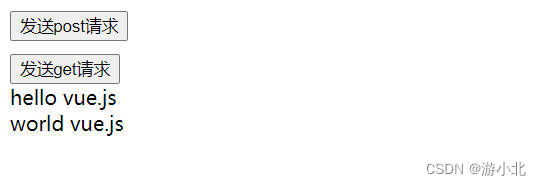组件是Vue是一个可以重复使用的Vue实例, 它拥有独一无二的组件名称,它可以扩展HTML元素,以组件名称的方式作为自定义的HTML标签。
因为组件是可复用的Vue实例, 所以它们与new Vue() 接收相同的选项
例如 data, computed、watch、methods以及生命周期钩子等。仅有的例外是像el这样根实例特有的选项。 把一些公共的模块抽取出来,然后写成单独的的工具组件或者页面,在需要的页面中就直接引入即可。
组件在封装好之后不存在父子关系,彼此相互独立,在嵌套使用时才存在父子关系。

通过 component 节点注册的是私有子组件
在父组件文件中:
(1)引入组件语法如下:
import '组件对象' from 'URL'
(2)导出组件 语法如下:
export default { }
(3)代码演示:
import hello from './components/hello.vue'
// export default {} 是固定写法 为了导出App组件
export default {
//此处定义了私有组件!
components: { hello },(1)在main.js文件中,引入 import '组件对象' from '文件路径'
(2)组件注册:Vue.component ('组件名','组件对象')
import Vue from 'vue'
import App from './App.vue'
//导入全局组件 world.vue
import world from '@/components/world.vue'
//注册 world.vue 组件
Vue.component('world', {
//可直接缩写为 world
'world': world
})
//-------以下为此全局组件(world.vue)的代码---------
<template>
<div id="world">
world vue.js
</div>
</template>
<script>
export default {
name: 'world'
}
</script>(3)最终效果

(1)在App.vue(即父组件) 中 script 标签中 使用 import 语法导入需要的组件
代码示例:
import hello from '@/component/hello.vue'
(2)接着使用 component 节点注册组件
代码示例:
export default {
data{},
component: {
// 'hello':hello简写为hello
hello
}
}(3)以标签形式使用注册好的组件
代码示例:
<template>
<div id='box'>
<hello></hello>
</div>
</template>感谢阅读!
以下为App.vue、main.js 和 html 的完整代码:
<template>
<div id="app">
<button id="post" v-on:click="post">{{message1}}</button>
<button id="get" @click="get">{{message2}}</button>
<hello></hello>
<world></world>
</div>
</template>
<script>
//此处导入局部组件
import hello from './components/hello.vue'
import World from './components/world.vue'
// export default {} 是固定写法 为了导出App组件
export default {
//此处定义了私有组件!
components: { hello, World },
// 导出的App组件名使用 name:'xxx' 定义
name: 'App',
// 在Vue组件中,data不能和以前一样一以对象的形式,
// 而应该使用函数的形式,在 return 中可以定义数据
// 属性之间用逗号隔开
data () {
return {
message1 : '发送post请求',
message2 : '发送get请求'
}
},
methods: {
post() {
console.log('发送了post请求')
},
get() {
console.log('发送了get请求')
}
}
}
</script>
<style lang="less">
button {
display: block;
margin-top: 10px;
}
</style>import Vue from 'vue'
import App from './App.vue'
//导入全局组件 world.vue
import world from '@/components/world.vue'
//注册 world.vue 组件
Vue.component('world', {
//可直接缩写为 world
'world': world
})
Vue.config.productionTip = false
new Vue({
render: h => h(App),
}).$mount('#app')<!DOCTYPE html>
<html lang="">
<head>
<meta charset="utf-8">
<meta http-equiv="X-UA-Compatible" content="IE=edge">
<meta name="viewport" content="width=device-width,initial-scale=1.0">
<link rel="icon" href="<%= BASE_URL %>favicon.ico" rel="external nofollow" >
<title>
<%= htmlWebpackPlugin.options.title %>
</title>
</head>
<body>
<noscript>
<strong>We're sorry but <%= htmlWebpackPlugin.options.title %> doesn't work properly without JavaScript enabled. Please enable it to continue.</strong>
</noscript>
<div id="app"></div>
<world></world>
</body>
</html>